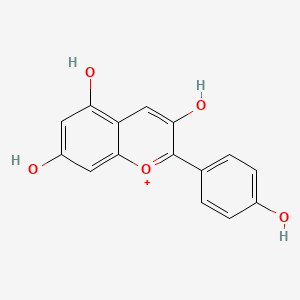| MeSH term | MeSH ID | Detail |
|---|---|---|
| Parkinsonian Disorders | D020734 | 20 associated lipids |
| Cystitis | D003556 | 23 associated lipids |
Pelargonidin
Pelargonidin is a lipid of Polyketides (PK) class. The involved functions are known as Uptake, Intestinal Absorption, glucose uptake, Process and Metabolic Inhibition. Pelargonidin often locates in Serosal, Mucous Membrane, brush border membrane, Membrane and Cell surface. The associated genes with Pelargonidin are SLC5A1 gene, SLC2A2 gene, Homologous Gene, F3 gene and CRSP3 gene. The related experimental models are Knock-out.
Cross Reference
Introduction
To understand associated biological information of Pelargonidin, we collected biological information of abnormalities, associated pathways, cellular/molecular locations, biological functions, related genes/proteins, lipids and common seen animal/experimental models with organized paragraphs from literatures.
What diseases are associated with Pelargonidin?
There are no associated biomedical information in the current reference collection.
Possible diseases from mapped MeSH terms on references
We collected disease MeSH terms mapped to the references associated with Pelargonidin
PubChem Associated disorders and diseases
What pathways are associated with Pelargonidin
There are no associated biomedical information in the current reference collection.
PubChem Biomolecular Interactions and Pathways
Link to PubChem Biomolecular Interactions and PathwaysWhat cellular locations are associated with Pelargonidin?
Visualization in cellular structure
Associated locations are in red color. Not associated locations are in black.
Related references are published most in these journals:
| Location | Cross reference | Weighted score | Related literatures |
|---|
What functions are associated with Pelargonidin?
Related references are published most in these journals:
| Function | Cross reference | Weighted score | Related literatures |
|---|
What lipids are associated with Pelargonidin?
There are no associated biomedical information in the current reference collection.
What genes are associated with Pelargonidin?
Related references are published most in these journals:
| Gene | Cross reference | Weighted score | Related literatures |
|---|
What common seen animal models are associated with Pelargonidin?
Knock-out
Knock-out are used in the study 'MATE2 mediates vacuolar sequestration of flavonoid glycosides and glycoside malonates in Medicago truncatula.' (Zhao J et al., 2011).
Related references are published most in these journals:
| Model | Cross reference | Weighted score | Related literatures |
|---|
NCBI Entrez Crosslinks
All references with Pelargonidin
Download all related citations| Authors | Title | Published | Journal | PubMed Link |
|---|---|---|---|---|
| Garcia-Alonso M et al. | Electron spin resonance spectroscopy studies on the free radical scavenging activity of wine anthocyanins and pyranoanthocyanins. | 2005 | Mol Nutr Food Res | pmid:16254886 |
| Park E et al. | A dose-response evaluation of freeze-dried strawberries independent of fiber content on metabolic indices in abdominally obese individuals with insulin resistance in a randomized, single-blinded, diet-controlled crossover trial. | 2016 | Mol Nutr Food Res | pmid:26842771 |
| Kassim A et al. | Environmental and seasonal influences on red raspberry anthocyanin antioxidant contents and identification of quantitative traits loci (QTL). | 2009 | Mol Nutr Food Res | pmid:19156716 |
| Stewart D et al. | Metabolomic approach to identifying bioactive compounds in berries: advances toward fruit nutritional enhancement. | 2007 | Mol Nutr Food Res | pmid:17492796 |
| Abraham SK et al. | Antigenotoxic effects of the phytoestrogen pelargonidin chloride and the polyphenol chlorogenic acid. | 2007 | Mol Nutr Food Res | pmid:17579891 |
| Kern M et al. | Limited stability in cell culture medium and hydrogen peroxide formation affect the growth inhibitory properties of delphinidin and its degradation product gallic acid. | 2007 | Mol Nutr Food Res | pmid:17729219 |
| Marinov BS et al. | Effects of pelargonidine and a benzocaine analogue p-diethylaminoethyl benzoate on mitochondrial K(ATP) channel. | 2001 | Membr Cell Biol | pmid:11699869 |
| Hämäläinen M et al. | Anti-inflammatory effects of flavonoids: genistein, kaempferol, quercetin, and daidzein inhibit STAT-1 and NF-kappaB activations, whereas flavone, isorhamnetin, naringenin, and pelargonidin inhibit only NF-kappaB activation along with their inhibitory effect on iNOS expression and NO production in activated macrophages. | 2007 | Mediators Inflamm. | pmid:18274639 |
| Roy M et al. | Action of pelargonidin on hyperglycemia and oxidative damage in diabetic rats: implication for glycation-induced hemoglobin modification. | 2008 | Life Sci. | pmid:18440560 |
| Zhang Y et al. | Human tumor cell growth inhibition by nontoxic anthocyanidins, the pigments in fruits and vegetables. | 2005 | Life Sci. | pmid:15680311 |
